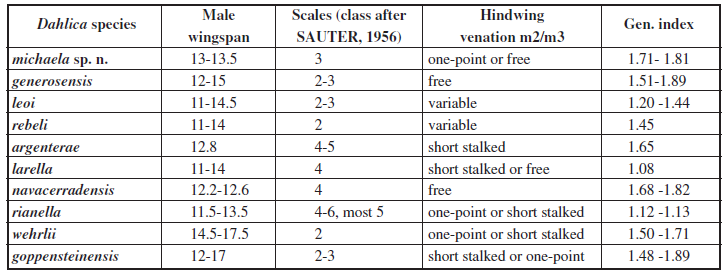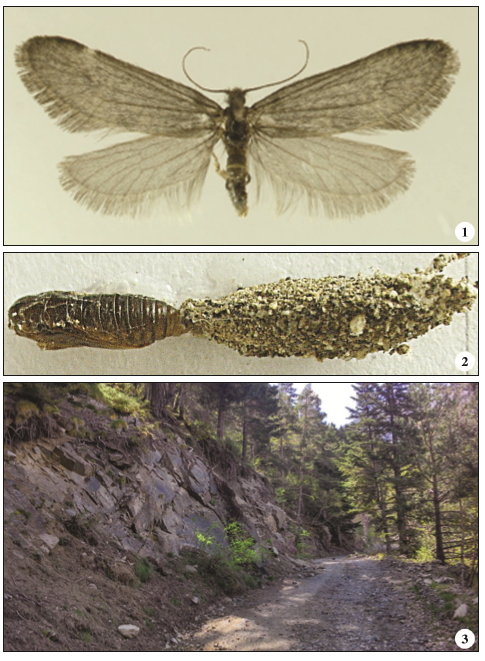

A new species of the genus Dahlica Enderlein, 1912 from the Pyrenees of Aragon (Province of Huesca) in Spain (Lepidoptera: Psychidae, Dahlicini)
Una nueva especie del género Dahlica Enderlein, 1912 de los Pirineos de Aragón (provincia de Huesca) en España (Lepidoptera: Psychidae, Dahlicini)
A new species of the genus Dahlica Enderlein, 1912 from the Pyrenees of Aragon (Province of Huesca) in Spain (Lepidoptera: Psychidae, Dahlicini)
SHILAP Revista de lepidopterología, vol. 44, núm. 173, 2016
Sociedad Hispano-Luso-Americana de Lepidopterología
Recepción: 26 Junio 2015
Aprobación: 29 Julio 2015
Abstract: A new Psychid, Dahlica michaela Arnscheid, sp. n. is described from the Spanish Pyrenees (Aragon, Huesca). The differences to other related species within the tribe Dahlicini is given.
Keywords: Lepidoptera, Psychidae, Dahlicini, Dahlica, new species, morphology, distribution, biology, Benasque, Huesca, Spain.
Resumen: Se describe un nuevo psíchido, Dahlica michaela Arnscheid, sp. n., de los Pirineos españoles (Aragón, Huesca). Se dan las diferencias con otras especies relacionadas dentro de la tribu Dahlicini.
Palabras clave: Lepidoptera, Psychidae, Dahlicini, Dahlica, nueva especie, morfología, distribución, biología, Benasque, Huesca, España.
Introduction
During the last 3 years the author visited several times the environment of Benasque, situated in the Pyrenees of Aragon (Huesca) to study the Psychid species of this and adjacent areas. Beside other interesting results, a new species of the tribe Dahlicini has been found, which is described here as:
Dahlica michaela Arnscheid, sp. n.
Material
Holotype: 1, Spain, Huesca, Benasque, Val Ballibierna, 1600 m, e. l., 16-V-2013, leg. W. Arnscheid (deposited at coll. A. Vives/Museo Nacional de Ciencias Naturales, Madrid, Spain). Paratypes: 3 11, same data (emerged 16-17-V-2013), 6 11, Val Ballibierna, 1400-1600 m, e. l. 10-15-V-2014, leg. W. Arnscheid, coll. W. Arnscheid (Bochum, Germany) and M. Weidlich (Neißemünde, Germany).
Description
Among the tribe Dahlicini only a few species are known from the Iberian Peninsula. These species belong either to genus Dahlica Enderlein, 1912 or Brevantennia Sieder, 1953. The latter is characterized by the short antennae of the female which bear less than 11 segments, mostly 3-5 and have a low genital index (mostly < 1.0) The former is characterized by the absence of a tarsal epiphysis which is present in the genus Siederia Meier, 1953, a genus which is until now not known from Spain or Portugal, as well as the alpine and south-east European genus Postsolenobia Meier, 1958.
Nevertheless, inclusion of the new species in the genus Dahlica is provisional. Due to the lack of females we could not verify definitively whether it belonged to Brevantennia, but the general appearance, the relatively broad scales on forewings and the higher genital index are good reasons for inclusion in Dahlica. Male wingspan 13 to 13.5 mm, wings stretched, slender, costal margin more or less straight, apex slightly pointed, forewing coloration blackish grey with regularly scattered whitish grey spots forming an indifferent reticular pattern which is very evenly distributed. The distal end of the discal cell without a dark spot. The scales between discal area and apex are relatively broad, mostly tridentate but also bidentate (mostly class 3 after SAUTER, 1956). The fringe scales are long, narrow with 3 dentations, light yellowish grey, very long towards anal margin. Venation on forewing with 9 veins emanating from discal cell, m1 and m2 free or rising from one point. Accessory cell present, intercalary cell absent. Hindwings slender, apex slightly pointed, lighter greyish. Fringes yellowish grey, longer towards anal margin. On hindwings 6 veins amanating from discal cell, m3 and m4 one point rising or free. Additional cells absent.
Head, thorax and abdomen covered with long yellowish grey hair-like scales. Eyes large, eyedistance distinctly larger than eye-diameter, labial palps reduced. Antennae thread-like, slightly longer than half forewing length, with 23-24 segments. Covered dorsally with small yellowish grey scales and short ciliated ones ventrally. Forelegs without tibial epiphysis, midtibia with one pair, hindtibia with two pairs of spurs.
Male genitalia typical for Dahlicini, tegumen oval, long in lateral view, indented distally, vaulted and narrower caudally. Vinculum narrow laterally, broader ventrally. Valva stretched and more slender and hairy distally. Broader basally, clasper of sacculus hook-shaped, mostly slender and curved upwardly, sometimes shorter and broad. Cucullus lobe-shaped. Saccus absent. Phallus long, distinct curved, thin, attached basally to fultura inferior by a long chitinized clasp, cornuti absent. Genital index (after SAUTER, 1956) 1.71 - 1.81 (n=4).
Female: Unknown.
Cases: Length 6-7 mm, width 1.9 to 2.1 mm. Greyish to dark yellowish brown, covered densely with particles of soil and other mineral debris, especially small stones. Partially scattered with particles of lichens.
Diagnosis and discussion
Beside the parthenogenetic species only a few sexual species of Dahlicini are known from the Iberian Peninsula. The first described species was Dahlica larella (Chrétien, 1906) from the Sierra de Guadarrama, Madrid. Smaller, distinctly lighter in coloration, the cases are more or less of unique shape in the genus and clearly different being broader and flatter. The genital index is distinctly lower (SAUTER, 1958). Also from Sierra de Guadarrama recently Dahlica navacerradensis Sobczyk, 2014 has been described. It differs also from the new species by the wingspan which is distinctly smaller. More greyish brown, head covered by grey hair-like scales (SOBCZYK, 2014). The white spots on forewing are confined to the outer half and very evenly scattered in the new species. On forewing it bears a dark spot on outer end of discal cell which is absent in D. michaela Arnscheid, sp. n. From Leon Province D. rianella Hättenschwiler, 1981 has been described. The genital index is lower and the scales much broader than in the new species (classes 4-6). From the Mediterranean coastline of Catalonia Brevantennia pinkeri Sieder, 1964 is much smaller (9.8-12.2 mm) and lighter greyish. It differs also by the genital index 0.90-1.05. Brevantennia estrelaArnscheid, 2012 from Serra da Estrela in Portugal is also smaller and differs beside other characteristics by the broader scales on forewing (classes 5-6).
Looking closer to other Dahlica species from west Europe only the alpine species D. argenterae (Wehrli, 1924), D. rebeli (Wehrli, 1924) and D. leoi (Dierl, 1970) resemble slightly the new species. The scales of D. rebeli and D. leoi are distinctly narrower (classes 2 and 2-3) and the genital index is lower in both species. D. wehrlii is larger in wingspan (14.5-17.5) and has very narrow scales as well as D. argenterae. The genital index of both species is lower.

Derivatio nominis: This nice new species is dedicated to my beloved wife Michaela Gärtner for her kind and useful companionship during the field work in the Iberian Peninsula, including at the type locality of the new species.
Bionomics
D. michaela Arnscheid, sp. n. is up to present only known from a little valley situated north of Benasque (Province of Huesca). The cases have been found to be very rare on rocks and large stones between 1400 and 1600 m in the coniferous belt with dense population of Buxus spec. and Ilex aquifolium. It seems quite certain that the flight period ranges from middle of May to early June. The larvae feed on algae and lichens. It is very interesting that at the type locality 2 other Dahlica species exist. At the same rocks the larval cases of the parthenogenetic forms of D. triquetrella (Hübner, [1813]) and D. lichenella (Linnaeus, 1761) have been collected and reared to adults. Furthermore the psychid species Diplodoma laichartingella (Goeze, 1783), Eumasia parietariella (Heidenreich, 1851), Pseudobankesia casaella Hättenschwiler, 1994 and Apterona nylanderi (Wehrli, 1927) occur in the habitat of D. michaela sp. n.
Agradecimientos
I am grateful to my friend Dr. Michael Weidlich, Neißemünde, for critical discussion as well as to Dr. Antonio Vives, Madrid, for his support to get permit for our field work in the Province of Huesca (Spain) into the Scientific Project of SHILAP
BIBLIOGRAPHY
ARNSCHEID, W., 2012.– Eine neue Art von Brevantennia (Sieder, 1953) von der Iberischen Halbinsel - Brevantennia estrela sp. nov. aus Portugal (Lepidoptera: Psychidae, Dahlicini).– Entomologische Zeitschrift, 122(4): 159-161.
CHRÉTIEN, P., 1906.– Du Solenobia larella Chrét.– Le Naturaliste28: 56-57.
DIERL, W., 1966.– Zur Kenntnis einiger Solenobia-Arten (Lepidoptera: Psychidae). Ein Beitrag zur Fauna Bavarica.– Mitteilungen der Münchner Entomologischen Gesellschaft 56: 190-196.
HÄTTENSCHWILER, P., 1977.– Neue Merkmale als Bestimmungshilfe bei Psychiden und von 3 neuen Solenobia DUP.– Arten.– Mitteilungen der Entomologischen. Gesellschaft Basel, 42: 33-60.
HÄTTENSCHWILER, P., 1981.– Eine neue Dahlica (= Solenobia auct.) aus Spanien (Lepidoptera, Psychidae).– Nota lepidopterologica, 4: 21-26.
HÄTTENSCHWILER, P., 1996.– Dahlica wehrlii (Müller-Rutz, 1920) wieder gefunden. Beschreibung des Weibchens und Ergänzungen zur Kenntnis des Männchens und der Ökologie (Lepidoptera, Psychidae).– Nota lepidopterologica, 18: 225-232.
SAUTER, W., 1956.– Morphologie und Systematik der schweizerischen Solenobia-Arten.– Revue Suisse de Zoologie, 63(3): 451-550.
SAUTER, W., 1958.– Zur Kenntnis von Solenobia fumosella Hein. und larella Chrét.– Mitteilungen der Schweizerischen Entomologischen Gesellschaft, 31: 328-332.
SOBCZYK, T., 2014.– Dahlica navacerradensis Sobczyk, sp. n. from Central Spain (Lepidoptera: Psychidae). – SHILAP Revista de lepidopterología, 42(165): 65-69.
Apéndice

Notas de autor